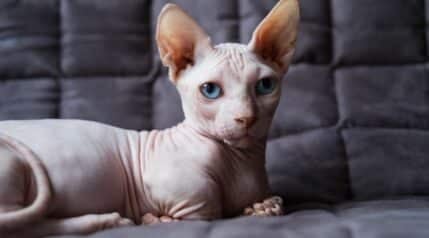When you purchase through links on our site, we may earn a commission. Here’s how it works.
If you had to list popular cat breeds quickly in a trivia competition, “Siamese” would likely be one of the first breeds to come to mind. These medium-sized cats who leap nimbly through life love to be by your side and partake in whatever fun is available. Siamese cats will amuse you with their antics and warm your heart with their affection. A Siamese mix cat can also be a wonderful feline companion.
While most blends won’t have the distinctive color and blue eyes of a Siamese, the Siamese personality is sure to shine through. If you’re in the market for an interactive, talkative feline companion, you can’t go wrong with a Siamese mix cat.
Your Siamese blend will likely be energetic and curious. Regardless of what other breed she’s crossed with, her Siamese half will add sparkle to her personality. Let’s get to know some of the most popular Siamese cat mixes.
Siamese Cat Breed History
The Siamese cat is an elegant breed with striking looks. Famous for their gorgeous blue eyes and colorpoint coat, these kitties are part of an ancient breed. They can be traced to Thailand, which was once known as Siam. No one knows how old the breed is, but according to The International Cat Association (TICA), they have been mentioned in writings as far back as the 14th century. The breed was kept in Thailand for centuries before making their way across the globe.
Siamese cats were thought to be favored by the royal family of Siam and served as guardians of sacred Buddhist temples. It wasn’t until the 1800s that the breed spread to Europe, premiering at the Crystal Palace Cat Show in London in 1871. Siamese cats came to the United States in 1878. The very first Siamese cat in the U.S. was a gift to President Rutherford B. Hayes and his wife, First Lady Lucy Hayes. The cat, Siam, was a gift from Bangkok’s American consul.
Siamese cats are playful, energetic, and very interested in human companionship. They can be either apple-headed or wedge-headed, with prominent pointed ears and almond-shaped blue or emerald-green eyes. Their elongated, slender bodies with long necks give them a very sleek appearance. Siamese kitties weigh between 10 and 15 pounds and stand 10 to 12 inches tall. They are fairly healthy and live between 15 and 20 years on average.
The Siamese cat breed stands out for its striking, colorpoint coats. Their bodies are usually lighter in color and paler, like cream, ivory, or fawn, with highly defined color points on the tail, legs, feet, mask, and ears. These points can come in a few different colors and shades, including chocolate, blue, lilac, seal, and chocolate.
Due to the genetic mutation that causes the Siamese cat’s colorpoint coat, they can change color when they are kittens. Their coats may get darker in the cold and lighten in warmer temperatures. They also start to darken in color as they mature.
7 Amazing Siamese Mixed Cats
Without further ado, let’s get to know these seven wonderful mixed Siamese cats. These are in no particular order because they are all awesome.
Siamese Tabby

When discussing the Siamese Tabby mix, we must remember that Siamese is a breed with the Himalayan color pattern, and tabby is simply a color group of patterns.
Shortly after World War II, breeders began working on adding more color to the Siamese breed. Using foundation stock of Siamese, Abyssinian, and red Domestic (American) Shorthair cats, breeders worked for years to create a red-point Siamese, which breeders crossed back to enhance the Siamese body type. When this cross produced a red-point Siamese, the Colorpoint Shorthair was born.
After establishing the first new colors, breeders crossed the tabby pattern into the mix, so kittens were born with distinctive tabby markings on their extremities and the tabby “M” on their faces. In 1969, this new color pattern, the lynx point Siamese, was accepted as a variety of Colorpoint Shorthair. They can be called the Siamese tabby, tabby point, or the lynx point Siamese.
Dedicated breeders created this cross, and the right combination of genes had to come together to make a stable breed. Both parent cats must pass the trait for the Himalayan colorpoint pattern to pass to a kitten. The tabby patterned parent would have to carry this recessive trait.
Siamese Maine Coon
When crossed with a Maine Coon, the slender Siamese’s body type will be tempered by the heft of the Maine Coon. These breeds are two extremes of body type, so a cross may tend towards either end of the spectrum. While Siamese cats are slender-bodied and long-limbed, the larger Maine Coon is a cobby-bodied cat.
The Maine Coone Siamese cross is larger than the average feline but shorthaired like the Siamese parent. Short hair is dominant to long hair, but this first-generation shorthaired cat could produce long-haired kittens depending on the cross.
When it comes to personality traits, the Maine Coon and Siamese are similar enough that a friendly, personable kitten is almost guaranteed. Both breeds enjoy playing in the water, and both are athletic. The Maine Coon does not climb about like a Siamese but is playful and intelligent. The Maine Coone Siamese cross is an easy-to-be-around, lively, people-oriented blend.
Siamese Ragdoll

The Ragdoll and the Siamese couldn’t look more different in terms of body type, but they both make excellent pets. The Ragdoll’s foundation mother was an unusually calm long-haired cat who would go limp like a rag doll when her owner held her. When bred, she consistently produced large colorpoint kittens with exceptionally calm dispositions.
Siamese cats are long, slender felines who are also wonderfully friendly. They aren’t as docile as a Ragdoll but are affectionate and loving. A Siamese Ragdoll blend will most likely have short hair because long hair, like the Ragdoll’s, is a recessive trait.
The Ragdoll is a heavier cat than the Siamese, but they both carry the Himalayan gene for color, so the kittens resulting from this cross will look like oversized Siamese. They’ll be playful and interactive but have rather laid-back personalities. Your Ragdoll Siamese mix will likely have personality traits from both breeds.
Siamese Calico

Once again, we have a mix of a breed with a color type. Many breeds can be calico, so your kitten’s body and personality type depend on the blend. The black, orange, and white pattern we know as calico results from a process known as “lyonization.” When a cat is XX (female), only one X can be expressed, so the other coils up in a process called lyonization.
If the calico cat has areas without pigment that appear white, she’s also piebald. If she has alleles that produce orange and black but no white spots (piebald), the pattern we see is called tortoiseshell. When the cat is a male, the Y chromosome makes lyonization unnecessary, so it is rare for male cats to be calico.
As far as body type and personality go with a Siamese calico cross, until we know the breed of the calico involved, we can’t make many predictions. Because short hair is dominant to long, all kittens with a purebred Siamese parent will be shorthaired kittens. The Siamese influence will lighten the frame of a round-bodied, heavy-boned cat. The calico parent could be a shy, quiet breed and temper the Siamese verve.
Siamese Bengal
The Siamese Bengal mix is guaranteed to produce an athlete. As an adult, she’ll likely weigh between ten and fifteen pounds and be moderately muscled. Interestingly, depending on the Bengal side of the equation, this mix may have the colorpoint trait appear.
Bengals come in the standard wild light brown with jaguar spot variety, which is dominant, and seal varieties. The seal lynx was created by crossing the Bengal with a Burmese. The Burmese colorpoint pattern came from a Tyrosinase mutation like the Siamese colorpoint pattern. In most cases, the offspring will have a pattern in the points if a Siamese cat is bred to a Seal Lynx Bengal. The pattern should breed through.
Both Siamese and Bengal cats have assertive personalities. The Siamese Bengal mix is affectionate and loyal, and it is able to leap around your house and reach heights like a few other blends. Their short, sleek coats will shed slightly less than other breeds. Bengals are exceptionally low-maintenance, and since they groom themselves less than other cats, they spread less Fel d 1 through their coats than other breeds. They may trigger fewer allergy symptoms than different Siamese mixes. Affectionate and tidy, the Siamese Bengal blend is a great family cat.
Siamese Russian Blue
Although the Siamese and the Russian Blue are strikingly beautiful, their personalities differ enough that your blended kitten may be a bit of a mystery when you first get to know her. Your Siamese Russian Blue blend will be a fine-boned cat with slender legs and a long tail. She’ll likely be less than fifteen pounds, and you’ll need to watch her diet. Although the Siamese is notably lean, the Russian Blue tends towards obesity.
Temperament-wise, it’s a mystery which personality type will prove dominant. If the Siamese is an extrovert, the Russian Blue is slightly introverted. The Russian Blue is a gentle cat, shy with strangers but devoted and loving with her family. She’s playful, and fetching is one of her favorite pastimes, but if things get noisy, she’ll retreat to a quiet place.
Siamese Persian

In the 1950s, breeders started working to develop a colorpoint variety of Persian. The first step in that direction was to cross Siamese with Persian to create a cat with the recessive traits necessary to make the next generation. After this, breeders established a group of colorpoint long-haired cats. These colorpoint longhairs were then bred back to Persians, and those cats eventually interbred to produce a Persian type. After many years and generations, cats with Persian looks and Himalayan colors were established.
First-generation crosses of Siamese and Persian will be shorthaired cats because short hair is dominant. If their parent is colorpoint or has a colorpoint recessive, the kittens could be colorpoint, but chances are their color will be determined by their Persian parent. The Siamese Persian cat’s temperament is likely quieter and gentler than a full Siamese counterpart. The Persian’s short-legged, heavier body may reduce the Siamese climbing tendency.
Siamese Mixed Cat Health
Siamese cats are more likely to have certain health disorders than some breeds. This means Siamese mix cats may be at higher risk or prone to certain medical concerns. Be sure to let your veterinarian know your best friend has Siamese in her ancestry so the two of you can make the best decisions about her care. It may not be apparent from her appearance that she’s part Siamese.
Amyloidosis
Amyloid protein can accumulate in the internal organs, typically the liver. Amyloid buildup can cause organ failure. While there’s no cure for amyloidosis, diet and medication can support the affected organ.
Megaesophagus
Megaesophagus has no cure, and Siamese cats are susceptible to this rare congenital condition. The tube to the stomach (esophagus) acts as if it is stretched out, and food never makes it to the gut but instead is regurgitated.
If your kitten regurgitates food frequently in a tube shape, consult your vet immediately. Feeding your cat as she “stands” or changing the consistency of his food may help, but the prognosis is poor for animals with this condition. They often aspirate pieces of food, which causes pneumonia.
Cancer
Lymphoma, thymoma, and adenosarcoma strike Siamese cats more than many other breeds, but luckily, most cases can be treated. Consult your vet to see if regular blood screenings for lymphoma are appropriate for your Siamese mix. These cancers can cause the production of abnormal white blood cells or tumors that can constrict the intestines. If you notice swollen lymph nodes, weight loss, labored breathing, or sudden vomiting and diarrhea, see your veterinarian as soon as possible.
Feline Hyperesthesia Syndrome
A cat with hyperesthesia feels sensations excessively. Both Siamese and Persian cats have a higher incidence of this disorder. Affected cats become hypersensitive to touch and may cry, run away, or try to gnaw the sensation away. Your veterinarian will determine the root cause of symptoms and, if necessary, prescribe medication to lessen your blend’s discomfort.
Convergent Strabismus
While convergent strabismus isn’t a problem in Siamese cats, you may notice that your Siamese blend’s eyes appear crossed (strabismus). In Siamese cats, this doesn’t seem to decrease their vision.
Progressive Retinal Atrophy (PRA)
Siamese and Russian Blues have a higher genetic instance of Progressive Retinal Atrophy (PRA). Progressive Retinal Atrophy causes blindness and may not strike until a cat is over a year old. If her parents have been genetically screened for this disease, you’ll know if she may be a carrier. It’s a recessive trait, so both parents would have to carry the gene for the disease to affect her, but she could pass it along if she has offspring.
You may want to consider pet insurance for your Siamese mix. Pet health insurance can help cover the cost of care in an emergency or illness. Learn more in our guide to learn about the best pet insurance options.
My Personal Experience With Siamese Mix Cats
I was lucky enough to raise a Siamese mix cat named Ace. He was a mix of Manx and Siamese cats. I found him as a stray kitten. Ace was one of the most giant cats I have ever met and also one of the sweetest and most intelligent. He was so large he could stand on his back legs and put his chin on the kitchen counter. I called him my peaceful giant due to his sweet demeanor and way of interacting with people.
Ace was very smart, and I trained him to walk on a leash so he could spend time outside, which he enjoyed. He was quite agile and physically powerful and loved to hunt, but he was also happy to curl up at my feet whenever I sat or lay down. I would take in another Siamese mix cat without hesitation.
3 Common Misconceptions About Siamese Cats
Siamese kitties have a reputation for being aloof, disinterested, or even ominous in some portrayals. Below, I clarify a few myths about the lovely Siamese kitty. If I missed one or you have a question, let me know in the comments.
1. Myth – Siamese Cats Are Aloof And Do Not Like People
Truth – Siamese cats are extroverted, friendly, and sociable. In fact, they are often described as one of the most social and playful cat breeds around. These cats LOVE people, will bond quickly with you, and love to be involved in whatever you are doing. You might even call the Siamese cat a social butterfly.
2. Myth – Siamese Cats Are Aggressive
Truth – The Siamese kitty is not aggressive. They can be independent, vocal, and assertive, but these kitties are generally not aggressive. Siamese kitties usually love children, dogs, and other cats. Of course, each kitty’s personality traits vary, but in general, the breed is affectionate, peaceful, and not aggressive.
3. Myth – Siamese Cats Are Quiet
Truth – Siamese cats can be quite chatty and even loud. They are not silent or sneaky when it comes to expressing their opinions. These kitties are also very communicative through body language and facial expressions.
Other Mixed Cat Breeds To Consider
Siamese mix cats make wonderful pets, but there are many others to consider. If you aren’t sure a Siamese mix is right for you, let me introduce you to a few other amazing kitties. You may want to consider a Maine Coon Norwegian Forest Cat, a Calico Ragdoll mix, or even a Savannah Bengal mix if you want a more exotic cat breed. All of these kitties have gorgeous looks and engaging personalities.
Why Trust Love Your Cat?
Danielle is a feline owner with over 30 years of experience. Cats have been an important part of her life since she was a toddler, and she has rescued every kitty she’s met that needed a home. She currently shares a home with two ten-year-old beauties she rescued as kittens. Danielle is a dedicated and skilled writer who works hard to stay on top of the latest science-backed research, developments, and trends in pet care, training, food, and products. Danielle works alongside a talented and committed team to provide pet owners with helpful and up-to-date information to better their lives.





